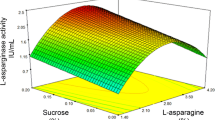Souhrn
Sledovali jsme vliv teploty na tvorbu zkvasitelných cukrů a vliv pH na dextrinační aktivitu při hydrolyse škrobu a bramborových zápar enzymatickými preparáty plísní Aspergillus niger a Aspergillus oryzae (plísňových otrub). Zjistili jsme toto:
-
1.
Při sledování vlivu teploty na tvorbu zkvasitelných cukrů u zcukřovaných bramborových zápar (doba zcukřování 60 minut) jsme nalezli různé optimální teploty účinnosti obou preparátů: A. niger 65 °C a A. oryzae 55 °C.
-
2.
Při těchto teplotách se vytvořilo preparátem A. oryzae 46,6 %, preparátem A. niger 56,1 % zkvasitelných látek vzhledem k přitomnému škrobu.
-
3.
Optimální zcukřovací teploty souhlasí téz s optimální činností dextrinační.
-
4.
Optimální hodnotou pH pro dextrinaci škrobu preparátem A. oryzae je 6,1; změnou pH (zvláště snizováním) je dextrinace značně zeslabována.
-
5.
Optimální hodnotou pH pro dextrinaci škrobu preparátem A. niger je 4,5; změny pH ji jen málo ovlivňují.
-
6.
Zjišt’ovali jme význam nízkého pH a relativně vysoké teploty při zcukřová ní škrobnatých surovin preparátem A. niger v lihovarské praxi.
Резюме
Изучалось влияние те мпературы на образов ание сбраживаемых Сахаро в и влияние рН на декстринизирующую с пособность при гидро лизе крахмала и картофель ных заторов ферментн ыми препаратами плесене й Aspergillus niger и Aspergillus oryzae (плесневого солода). Было установлено, что разл ичие между препарата ми А. niger и A. oryzae в отношении образова ния. сбраживаемых Сахаро в при 60 минутном осахар ивании картофельных заторо в проявляется их оптимальными темп ературами. (А. niger 65 °С, А. oryzae 55 °С .) При этих температурах под действием препар ата А. oryzae образовалось 46,6 % сбраживаемых вещест в, а под действием препарата А. niger, соответ ственно, 56,1 %, от присутст вующего крахмала. Оптимальны е температуры соответ ствуют также оптимал ьному декстринизирующему действию. Оптимальным рН для де кстринизации крахма ла препаратом А. oryzae являет ся рН = 6, 1, причем изменение рН, в особенности в сторон у повышения кислотности, вызываю т значи тельное понижение декстрини зации. Оптимальным рН для декстринизации крах мала препаратом A. niger является рН = 4,5, причем изменения рН оказыва ют на декстринизацию лишь незначительное влияние. Обсуждается вопрос о значении низкого рН и сравнительно высокой температуры при осахаривании крахмалсодержащих м атериалов препарато м А. niger в практике спиртовой промышленности.
Summary
A study was made of the influence of temperature on the formation of fermentable sugars and of the influence of pH on dextrination activity in the hydrolysis of starch and potato mash by enzymatic preparations of the moulds Aspergillus niger and Aspergillus oryzae (mould bran). The findings were as follows: On 60 minutes’ saccharification of potato mash, preparations of A. niger and A. oryzae differed in relation to the formation of fermentable sugars as regards their optimal temperatures (A. niger 65 °C, A. oryzae 55 °C). At these temperatures the preparation of A. oryzae formed 46.6% and the preparation of A. niger 56.1 % fermentable sugar in relation to the amount of starch present. The optimal temperatures also correspond to optimal dextrination activity. Optimal pH for the dextrination of starch by the preparation of A. oryzae is 6.1 and a change in pH in the acid direction causes a considerable decrease. Optimal pH for the dextrination of starch by the preparation of A. niger is 4.5 and changes in pH have little effect. The significance of a low pH and the relatively high temperature in the saccharification of starchy raw materials by the A. niger preparation is discussed with reference to distilling practice.
Similar content being viewed by others
Literatura
Adams, S. L., Balankura, B., Andreasen, A. A., Stark, W. H.: Submerged culture of fungal amylase. Ind. Eng. Chem. 39: 1615, 1947.
Beran, K., Burger, M.: Nová gasometrická metoda stanovení cukrů vykvašová ním za přítomnosti 2,4-dinitrofenolu. Chem. listy 49: 1693, 1955.
Belozerskij, A. N., Proskurjakov, N. I.: Praktičeskoje rukovodstvo po biochimiji rastenij. Moskva 1951.
Burger, M., Beran, K.: K otázce mechanismu hydrolysy dextrinů plísňovými enzymatickými preparáty. Chem. listy 48: 1394, 1954.
Burger, M., Beran, K.: O mechanismu účinku maltásy plísně Aspergillus niger.I. Vliv teploty na aktivaci hydrolysy škrobu plísňovými preparáty. Chem. listy 50: 133, 1956.
Feniksová, R. V.: Plesnevyje griby iz roda Aspergillus kak producenty amilazy. Mikrobiologija 22: 28, 1953.
Green, S. R., Stone, I.: Fermentability of wort trisaccharide, a factor in variable attenuations. Wallerstein Lab. Comm. 15, 51: 347, 1952.
Klimovskij, D. N., Rodzevič, V. Z.: Amilolitičeskije fermenty u aspergilov. Mikrobiologija 19: 60, 1950.
Lu Cheng Hao, Fulmer, E. I., Underkofler, L. A.: Fungal amylase as saccharifying agents in the alcoholic fermentation of corn. Ind. Eng. Chem. 35: 814, 1943.
Lu Cheng Hao, Jump, J. A.: Microbiol. amylase preparation conversion agents for alcoholic fermentation. Ind. Eng. Chem. 37: 521, 1945.
LeMense, E. H., Lohns, V. E., Corman, J., Blom, R. H., Van Lanen, J. M., Langlykke, A. F.: Grain alcohol fermations submerged mold amylase as a saccharifying agent. Ind. Eng. Chem. 41: 100, 1949.
Roberts, M., Laufer, S., Stewart, F. D., Laletan, L. I.: Saccharification of wheat by fungal amylases for alcohol production. Ind. Eng. Chem. 36: 811, 1944.
Schwene, L., Fulmer, E. I., Underkofler, L. A.: Saccharification of starch grain mashes for the alcoholic fermentation industry. Ind. Eng. Chem. 32: 544, 1940.
Stárka, J.: Hodnocení amylolytických enzymových preparátů papírovou chromatografií. Čs. biologie 3: 230, 1954.
Takamine, J. O.: Enzymes of Aspergillus oryzae and the application of its amyloclastic enzyme to the fermentation industry. Ind. Eng. Chem. 6: 824, 1914.
Teixeira, C., Andreasen, A. A., Kolachov, P.: Ethyl alcohol from casava. Ind. Eng. Chem. 42: 1781, 1950.
Underkofler, L. A., Fulmer, E. I., Schwene, L.: Saccharification of starch grain mashes for the alcoholic fermentation industry. Ind. Eng. Chem. 31: 734, 1939.
Underkofler, L. A., Severson, G. M., Goering, K.J.: Saccharification of grain mashes for alcoholic fermentation. Plant-scale use of mold amylase. Ind. Eng. Chem. 38: 980, 1946.
Author information
Authors and Affiliations
Rights and permissions
About this article
Cite this article
Beran, K., Burger, M. Studium optimálních podmínek pro zcukřování bramborových zápar plísňovými enzymatickými preparáty. Československá Mikrobiologie 1, 97–104 (1956). https://doi.org/10.1007/BF02892353
Received:
Issue Date:
DOI: https://doi.org/10.1007/BF02892353




